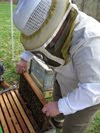

Bees and people aren't too much different.
When a person dies there are people who have the special job of taking care of the dead body.
When a bee dies there are workers who have the special job of taking care of the dead body.
See? Bees are like people... or maybe people are like bees.
Nature is marvelously designed so that each little bit and piece is not wasted. When we see a dead animal on the side of the road it can be sad. But nature will take care of these corpses by helping to remove them. Little beetles and flies that specialize with dead animals will come and do their job.
If a bee dies outside in the field, she'll fall to the ground. Her body will most likely become a meal for a foraging mouse, a bird, wasps or ants.
Where my bee hives are I've watched as a bird flew down to pick up dead bees to eat.
Inside the hive, if the bodies of dead bees can't be left to pile up otherwise there would be a crowded mess. And it wouldn't be clean.
Have you ever picked up a dead fly and found it to be very lightweight? That's because it's body has dried out over a few days.
Undertaker bees will sometimes wait a few days so a dead bee body will dry out. Then it won't be so heavy to carry.
They grab the body and half fly and half drag it out of the hive. Sometimes the bee will be heavy and big like the drone in these photos and video. Then another undertaker bee will come and help.
They'll pull and yank the dead bee across the platform outside the hive. At the edge they'll actually fly off, carrying the body and then they'll drop it.
It's all in a day's work for the undertaker bees.














 What? It's true. They do.
What? It's true. They do.








